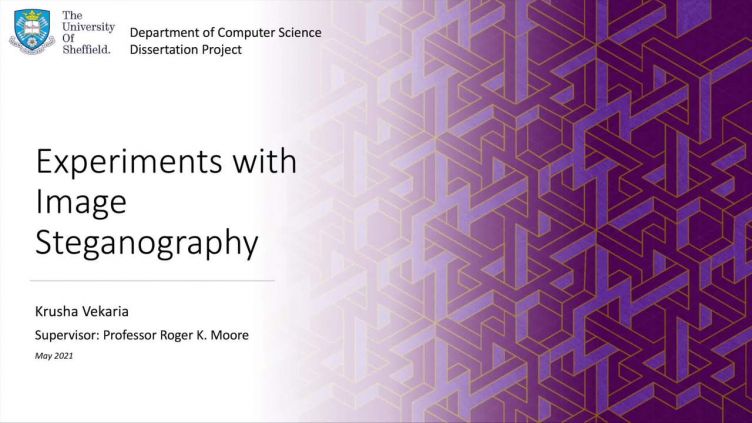Is a picture really worth a thousand words?
An exploration into Digital Image Steganography and the journey of a third year Dissertation Project by Krusha Vekaria

Dissertations! Growing up, you always see and hear about them in movies and shows.Locked away in your room, tirelessly writing away; an impossible feat. Well, now, as a fourth year student, I can officially say that I’ve done it! Turns out, it’s not as scary as it seems…
What if the clothing images that you were scrolling through whilst online shopping contained the details of a military operation? What if a family picture posted on social media delivered the plans of the next terrorist attack? These are the questions that arise when learning about the art of Steganography; a field of Information Security that aims to conceal the fact that information was ever sent.
From the Ancient World to the World Wars, Steganography has been used for covert communication. Its ability to protect information by concealing it makes it a unique method of communication; with the increased use of technology, its digital applications are being researched and improved.
From invisible ink to playing an audio track backwards to reveal a message, there are many forms of Steganography. But the one I found the most interesting was hiding text in an image. How is this even possible?! As a self-proposed project, coming up with your own research question is part of the process. So after many Google searches trying to better understand this topic, I decided to focus on an experimental dissertation, answering “to what extent does the amount of information being embedded into an image effect the image quality and how does this vary depending on the different methods.”
Despite having constructed the question myself, even I struggled to understand it at first. However, with the help of my supervisor, Professor Roger Moore, I was able to break it down into more manageable tasks that could then be tackled systematically. Having regular meetings helped the project run smoothly. His advice and guidance along the way gave me the confidence and ability to produce a first class dissertation. Although it is common for your supervisor to specialise in your research area, they are here to support you, question you and encourage you to produce your best work. After all, it is your supervisor that is with you from start to finish.
Over the months, the pieces of my project slowly started to fit together. I explored the most common forms of Image Steganography, categorising them into methods that either hid the text just below the surface of an image or dug more deeper to bury the text. The practical element of building all the systems came with their own challenges and an endless list of errors; something computer scientists know all too well (Taylor’s Version). However, having researched how each of these systems work made it slightly easier to resolve this problems. I could finally run experiments and gather data to produce results. Yay! It was rewarding to see many of my findings correspond to what I’d researched. It was also just as interesting to identify any anomalies, as these became points of discussion and improvement.
One of my biggest challenges was setting a realistic goal. Halfway through the project, I fell into a slump and had to reassess what I wanted to achieve and make changes accordingly. I learnt to not be afraid to stray away from my original plan. Changes can be beneficial. This process also taught me of the importance of having confidence in yourself. Undertaking such long projects will come with its hurdles, but having that faith in yourself can help you overcome them.
Finally, to answer whether a picture can be worth a thousand words?… Yes, it can! Whether it’s apparent or not from the quality of the image, this project has proven this through the art of Steganography (just take my word for it).

Visit us
Discover what sets Sheffield apart at our undergraduate open days on Saturday 21 June and Saturday 5 July 2025.


